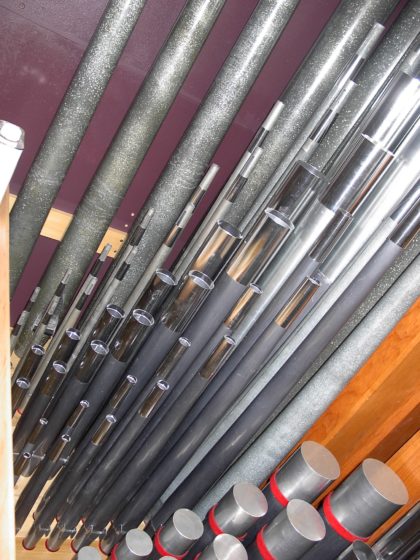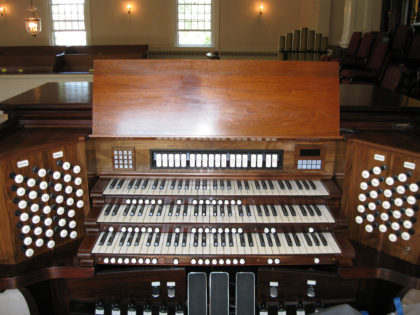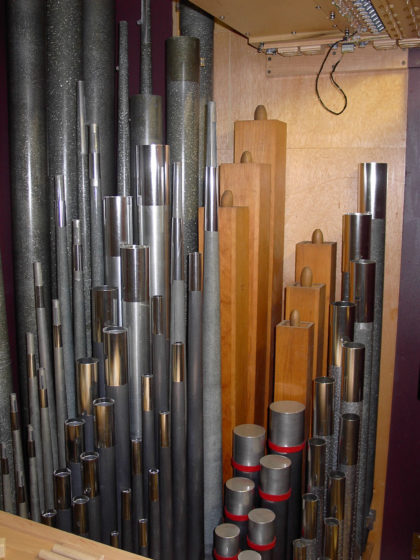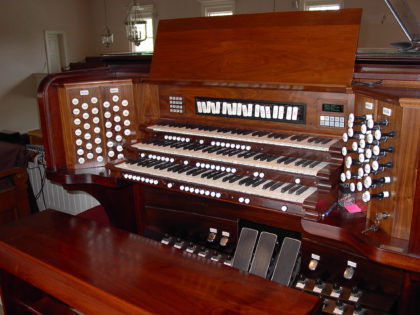About Our Organ
Jump to: From the Organ Builder; From the Organist; Organ Specifications
Russell & Company, Opus 54, III/46 ranks
From the organ builder
First Parish in Concord’s building is a classic New England meeting house built in 1901. It replaced and is a very close reproduction of the preceding building (built on the same stone foundation), which burned to the ground the year before. The church is of wood frame construction with relatively soft plaster walls and natural pine flooring. The room has a fairly dry acoustic that has now been enhanced nicely by removing the carpeting from the ground floor and exposing as many of the natural wood surfaces as possible. The large music program includes adult and children’s choirs, as well as a contemporary ensemble and handbell choir.
The organ that preceded the new instrument began its life in 1901 as Austin’s opus 54 – a three-manual instrument of some 37 ranks. In 1901 is was very similar in specification to several organs of that size and day being built by the Austin Organ Company and not really designed with a specific room or space in mind. The original installation was problematic in that it was designed around the layout required by the Austin Mechanism and thus had minimal tonal egress through two small sets of expression shades.
In the late 1930s the noted American organ builder E.M. Skinner was hired to rebuild parts of the organ and convert the instrument to electric (electro-pneumatic) action. He installed a new console with all the modern improvements of the day but preserving the original mechanical swell shade linkages. That work also included the replacement of several sets of pipes to expand the tonal palette of the instrument with unique colors found in many E. M. Skinner organs.
By the 1970s the organs mechanism was failing. During that period, the study and interest of Baroque music and performance practice was at the forefront of organ teaching and musicology. The organ was quite lacking in the upper work and narrower pipe scales necessary to effectively play Baroque and contemporary organ music well so that the intricate counterpoint could be heard clearly. To that end, another rebuild was undertaken to make additions of mixtures and mutation pipes. The result was an instrument that was a mismatch of the original broader foundation tone with a very thin and a rather shrill sound at the top, with very little in the middle. The additions could best be described as “insensitive” to the rest of the organ. It was incoherent within itself as a musical whole and the additions, added to an already compromised layout, made parts of the organ unserviceable.
 When I came to see the church and organ the first time, I was fascinated by the challenge and charge to build an eclectic organ that would encompass both the American Classic style of organ building that comes to us from the legacy of the Aeolian-Skinner Organ Company and yet incorporate the broader sounds of the symphonic Organ as well – an organ that would truly play all the organ literature and effectively support and inspire congregational singing, and accompany the choir and instrumentalists as well. I also was able to point to a recent larger organ we had built at First Presbyterian Church in Ithaca, New York. Their preceding organ was also an Austin from the same era as the First Parish instrument with similar issues regarding subsequent rebuilds. First Parish had already done their homework and done a specific organ study which revealed that a rebuild of the existing instrument would cost nearly as much as a new instrument with a new layout, while failing to mitigate any of the musical issues with that organ. Therefore, the charge was to offer a proposal for a newly designed organ, which would incorporate all worthwhile pipework from the existing organ. It was a challenging space and project for the budget, but I felt we were up to it. After a regional search Russell & Company of Chester, Vermont was selected to build a new organ for the church with the intent of utilizing, as much as possible, the best pipework from the old organ. This was both in the spirit of valuing, honoring, and building on the past and also recycling for the future. In other words, a green solution that was compatible with the Unitarian Universalist faith and tradition.
When I came to see the church and organ the first time, I was fascinated by the challenge and charge to build an eclectic organ that would encompass both the American Classic style of organ building that comes to us from the legacy of the Aeolian-Skinner Organ Company and yet incorporate the broader sounds of the symphonic Organ as well – an organ that would truly play all the organ literature and effectively support and inspire congregational singing, and accompany the choir and instrumentalists as well. I also was able to point to a recent larger organ we had built at First Presbyterian Church in Ithaca, New York. Their preceding organ was also an Austin from the same era as the First Parish instrument with similar issues regarding subsequent rebuilds. First Parish had already done their homework and done a specific organ study which revealed that a rebuild of the existing instrument would cost nearly as much as a new instrument with a new layout, while failing to mitigate any of the musical issues with that organ. Therefore, the charge was to offer a proposal for a newly designed organ, which would incorporate all worthwhile pipework from the existing organ. It was a challenging space and project for the budget, but I felt we were up to it. After a regional search Russell & Company of Chester, Vermont was selected to build a new organ for the church with the intent of utilizing, as much as possible, the best pipework from the old organ. This was both in the spirit of valuing, honoring, and building on the past and also recycling for the future. In other words, a green solution that was compatible with the Unitarian Universalist faith and tradition.
A profusion of new romantic organs in recent years, as well as a renewed reverence and interest in the work of early 20th-century American builders, specifically Skinner and early Casavant organs, was the milieu for the design and construction of this instrument. While Russell & Co. have built several large instruments along French romantic lines, as well as classic tracker organs in the classic Germanic tradition, building an eclectic organ that could encompass both the American Classic and French romantic organs for a somewhat dry acoustic was a challenge we were up for.
We knew we could take all the lessons learned from our previous instruments, combine them with a century of progress in American organ building, and produce an organ of beauty that would prove useful in accompanying congregational song, playing choral and orchestral literature, and still be able to play the solo organ repertoire. While the presence of well-developed and blended choruses in each division was of foremost importance, so to was the mandate for colorful orchestral voices and the overall ensemble of the instrument. The goal was always to have warmth of character and tone that work best in a room like the First Parish sanctuary, yet remain clear without becoming shrill at the top end.
Once the pipework from the old instrument was removed and more carefully evaluated, we discovered that much less was useable for the tonal plan and goal than we had originally hoped. We then revised how much of the pipework would need to be made new and began the process of manufacturing most of those ranks of pipes. The blended diapason choruses for each of the three keyboards came first. Some of these pipes were manufactured from some of the former Austin pipework, but in different locations and scaling, some from early Estey pipework, and most fabricated completely new. Each rank of pipes was scaled and finished as a complete musical instrument within itself. The Swell and Great organs are capped by new custom designed compound mixture pipes, scaled to specifically blend with their individual chorus of pipes. Opus 54 has ten different ranks of flute pipes, each individually unique in sound and voicing. Only two of those ranks came from the former instrument, and one of those is in the pedal organ. The reeds are from historic and beautifully crafted early pipework of Casavant Freres of Quebec, Canada and E.M. Skinner, most notably the Tuba Harmonique, which was originally in his organ located in the old Capitol Theatre in Boston. It is run by its own blower on 12” of wind pressure, while the rest of the organ runs on 4” of wind pressure. It grandly towers over full organ, while never becoming edgy. The large wood pedal pipes of this organ represent the majority of pipes retained from the 1901 Austin. This was largely because of the budget and potential cost for replacing such large pipes. They have been cleaned up, refinished, and refined as much as possible and make an admirable contribution to an organ of this size. This pipe organ has 53 stops and 46 ranks of pipes over three manuals and pedal.
 Lastly, it was the desire of the organist, Eric Huenneke, to have the new organ console downstairs so he could hear and experience the organ “in the room” and from a distance, especially in service playing – having the congregational singing coming towards him with the organ behind and supporting. Having the console moveable would also allow for a variety of positions down front for concert use. However, there would still be a need for a console in the balcony for when the choir or instrumental ensembles were combined with the organ. This did not initially seem possible in terms of practicality or budget, but within the first several months it was determined that it did make sense to rebuild to some degree the E.M. Skinner console of the former organ for this purpose, rather than figure out some other lesser solution. This turned out to be a very effective solution for these past few years as the rest of the organ was being completed. Of course, like so much else with this instrument, there was more to be done than originally requested, but somehow it eventually got done with much patience from the organist and the church. The balcony console was expanded to include the additional stops for the new organ, has new pedal tops, and was completely refinished. It has a new solid-state operating system and retains the restored original ivory keyboards. The new console on the ground floor is of walnut, stained to match the pulpit, with Harris drawknob stop actions with a pedal board of maple and ebony keys. Both consoles share a Classic Organ Works solid-state operating system with 250 levels of memory, which allows organists to save and store registration combinations, and record and play back the organ when desired.
Lastly, it was the desire of the organist, Eric Huenneke, to have the new organ console downstairs so he could hear and experience the organ “in the room” and from a distance, especially in service playing – having the congregational singing coming towards him with the organ behind and supporting. Having the console moveable would also allow for a variety of positions down front for concert use. However, there would still be a need for a console in the balcony for when the choir or instrumental ensembles were combined with the organ. This did not initially seem possible in terms of practicality or budget, but within the first several months it was determined that it did make sense to rebuild to some degree the E.M. Skinner console of the former organ for this purpose, rather than figure out some other lesser solution. This turned out to be a very effective solution for these past few years as the rest of the organ was being completed. Of course, like so much else with this instrument, there was more to be done than originally requested, but somehow it eventually got done with much patience from the organist and the church. The balcony console was expanded to include the additional stops for the new organ, has new pedal tops, and was completely refinished. It has a new solid-state operating system and retains the restored original ivory keyboards. The new console on the ground floor is of walnut, stained to match the pulpit, with Harris drawknob stop actions with a pedal board of maple and ebony keys. Both consoles share a Classic Organ Works solid-state operating system with 250 levels of memory, which allows organists to save and store registration combinations, and record and play back the organ when desired.
Those at Russell & Company who have worked on the building of this instrument are:
Stephen Russell (all aspects of the project)
Carole Russell (organ pipes)
Mayu Allen (pipes and installation assistance)
Paul Elliott (woodworking – chancel console)
Erik Johansson (woodworking – organ parts, wood pipe repairs)
Larry Nevin (voicing, tonal finishing)
Jason Ballard (woodworking – gallery console, organ parts and structure)
Jonathan Ortloff (woodworking, organ parts and structure)
Oliver Schemm (woodworking-apprentice, organ parts (Expression shades)
Stephen J. Russell
From the Organist
It is with great joy that we welcome the completion of Russell & Company’s Opus 54 for First Parish in Concord. From the first Russell organ I played during our many organ committee visits to several churches and organ builder’s work in New England, I immediately felt at home and at ease. The Russell organs I tried just seemed to sit well within their respective rooms and had a musical warmth and character grounded in tonal integrity, classic organ design, and a refined musical taste.
After recommendations by professional acousticians and an Acoustics Task Force review of those recommendations, and with plans to replace the carpeting on the ground floor anyway, we decided to just see what the room actually sounded like without any carpeting downstairs. The upstairs already had the plain painted floors. We found that when the room is empty and free of sound absorbing carpets, it is actually quite ideal for most music and speech and many musicians have commented on its responsiveness. Thus, it was agreed to simply paint the floor and install aisle runners with the least padding. Relying on the natural surfaces in the room has proven quite effective for the most realistic and natural acoustic both for music and speech.
 One of the things I really appreciated when I met with Stephen Russell the first time and we sat at the old organ together was that he listened to what I had to say – what I felt would work best in the room in terms of sound from my experience and I realized we actually were on the same wave length. I showed him what I thought worked musically on the old instrument in that room and what definitely didn’t. We talked about what a diverse music program we had at First Parish and how the organ needed to reflect that same variety in color, yet be firmly grounded in a beautiful blended ensemble. It was agreed the organ should have electro-pneumatic actions with wind chests of the Pitman design. Right around the time the church signed a contract with Russell, we went and heard a concert on his recently completed organ at First Presbyterian Church in Ithacca. It is a fabulous and large instrument, but the most striking thing is that it just seemed so right for the room and again like it had always been there. It fit the room because he designed it for the room. It has a profusion of beautiful orchestral colors and a very pleasing and refined blend of all the divisions.
One of the things I really appreciated when I met with Stephen Russell the first time and we sat at the old organ together was that he listened to what I had to say – what I felt would work best in the room in terms of sound from my experience and I realized we actually were on the same wave length. I showed him what I thought worked musically on the old instrument in that room and what definitely didn’t. We talked about what a diverse music program we had at First Parish and how the organ needed to reflect that same variety in color, yet be firmly grounded in a beautiful blended ensemble. It was agreed the organ should have electro-pneumatic actions with wind chests of the Pitman design. Right around the time the church signed a contract with Russell, we went and heard a concert on his recently completed organ at First Presbyterian Church in Ithacca. It is a fabulous and large instrument, but the most striking thing is that it just seemed so right for the room and again like it had always been there. It fit the room because he designed it for the room. It has a profusion of beautiful orchestral colors and a very pleasing and refined blend of all the divisions.
There was an organ study committee and three subsequent organ committees that worked on this project. Their dedication and thought given was an invaluable contribution in selecting Russell & Co. as our organ builder. When the three finalist’s proposals were received and studied, it was clear without a doubt that Stephen Russell’s proposal was exceptional in its use of the space, variety and musicality of the organ specification, amount of completely new pipework, undergirded by a firm grounding on the principles of classic organ design. It was the most unanimous, least deliberated, and quickest decision the committee made in its nearly two year process. It was personally the happiest day of the organ project process for me next to the actual completion of the instrument.
Russell & Company, Opus 54 can convincingly play the organ repertoire spanning five centuries with clarity. It has cohesive and convincing choruses in each organ division, offers varied orchestral colors, and shimmers with the sound of the silvery mixtures in earlier countrapuntal music. It’s crowning glory is the resurrection of the mighty Tuba Harmonique of E.M. Skinner heard once again above it all. May this great pipe organ serve First Parish in Concord and the larger community for generations yet to come.
 We gratefully acknowledge the following individuals who have contributed in one way or another to this organ project and our new organ:
We gratefully acknowledge the following individuals who have contributed in one way or another to this organ project and our new organ:
Sara Ballard, Nancy & Rein Beeuwkes, Holly Cratsley, Patricia Cumings, Rebecca Curzon, David Dawson, John Esty, Tamasin Foote, Ross Harris, D. Eric Huenneke, Leah Huenneke, David Kelch, George King, John Lang, Hugo Logemann, Peter Mitchell, Richard Moore, Spencer Harris Morfit, Elizabeth Norton, Joseph Peixoto, Bernard Schlager, Barbara Tolman, Timothy Warren, Alan Whitney, Tom Wilson
Professional Consultants: Jonathan Ambrosino, Charles Callahan, Stuart Forster, Allen Hill
D. Eric Huenneke
Organist, First Parish in Concord
September 2016
Concord, Massachusetts
Organ Specifications
(The 1901 Austin Facade has been retained.)
GREAT
| 16 | Contra Diapason | 61 | Pipes | |
| 8 | Montre | 29 | pipes, 1-32 Pedal Octave | |
| 8 | Principal | 61 | Pipes | |
| 8 | Harmonic Flute | 49 | Pipes | |
| 8 | Bourdon | 61 | Pipes | |
| 4 | Octave | 61 | Pipes | |
| 4 | Rohr Flute | 61 | Pipes | |
| 2 2/3 | Twelfth | 61 | Pipes | |
| 2 | Fifteenth | 61 | Pipes | |
| IV | Fourniture | 244 | Pipes | |
| 8 | Trumpet | 61 | Pipes |
CHOIR
| 8 | English Diapason | 61 | pipes | |
| 8 | Bourdon | 61 | pipes | |
| 8 | Erzähler | 61 | pipes | |
| 8 | Erzähler Celeste tc | 49 | pipes | |
| 4 | Octave | 61 | pipes | |
| 4 | Koppel Flute | 61 | pipes | |
| 2 2/3 | Nasard | 61 | pipes | |
| 2 | Block Flute | 61 | pipes | |
| 1 3/5 | Tierce | 61 | pipes | |
| 8 | Clarinet | 61 | pipes | |
| 8 | Tuba Harmonique | 61 | pipes | |
| Tremulant | ||||
| Chimes | ||||
| Choir 16 | ||||
| Choir Off | ||||
| Choir 4 |
SWELL
| 16 | Lieblich Gedeckt | 61 | pipes | |
| 8 | Diapason | 61 | pipes | |
| 8 | Bourdon | 49 | pipes | |
| 8 | Viola Pomposa | 61 | pipes | |
| 8 | Viola Celeste | 61 | pipes | |
| 4 | Octave | 61 | pipes | |
| 4 | Nachthorn | 61 | pipes | |
| 2 | Octavin | 61 | pipes | |
| IV-V | Plein Jeu | 297 | pipes | |
| 16 | Contra Oboe | 12 | pipes | |
| 8 | Trompette | 61 | pipes | |
| 8 | Oboe | 61 | pipes | |
| 8 | Vox Humana | 61 | pipes | |
| Vox Tremulant | ||||
| Tremulant | ||||
| Chimes | prepared | |||
| Swell 16 | ||||
| Swell Off | ||||
| Swell 4 |
PEDAL
| 32 | Contra Bourdon | resultant | ||
| 16 | Open Wood Diapason | 32 | pipes | |
| 16 | Contra Diapason | Great | ||
| 16 | Bourdon | 32 | pipes | |
| 16 | Lieblich Gedeckt | Swell | ||
| 16 | Violone | 32 | pipes | |
| 8 | Octave | 32 | pipes | |
| 8 | Bourdon | 12 | pipes | |
| 8 | Cello | 12 | pipes | |
| 4 | Choral Bass | 32 | pipes | |
| 4 | Harmonic Flute | Great | ||
| V | Mixture | 48 | pipes, draws choralbass | |
| 32 | Contra Trombone | 1-12 resultant | ||
| 16 | Trombone | 12 | pipes | |
| 16 | Contra Oboe | Swell | ||
| 8 | Trumpet | Great | ||
| 8 | Trompette | Swell | ||
| 4 | Oboe | Swell | ||
| Pedal Silent | ||||
| Pedal Divide |
COUPLERS
| Great to Pedal 8 |
| Swell to Pedal 8 |
| Swell to Pedal 4 |
| Choir to Pedal 8 |
| Choir to Pedal 4 |
| Swell to Great 16 |
| Swell to Great 8 |
| Swell to Great 4 |
| Choir to Great 16 |
| Choir to Great 8 |
| Choir to Great 4 |
| Swell to Choir 16 |
| Swell to Choir 8 |
| Swell to Choir 4 |
| Choir to Swell 8 |
| Great to Swell 8 |
| French Manual Transfer |
| All Swells to Swell |
MIDI
| MIDI on Great I, II, III, IV |
| MIDI on SwellI, II, III, IV |
| MIDI on Solo I, II, III, IV |
| MIDI on Pedal I, II, III, IV |
Classic Organ Works
Markham, Toronto, Ontario, Canada
250 levels of memory


You must be logged in to post a comment.